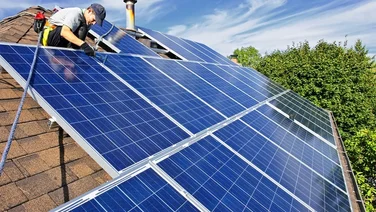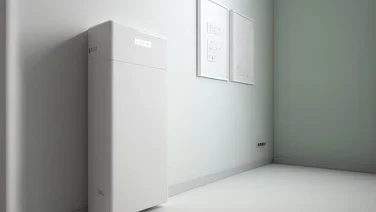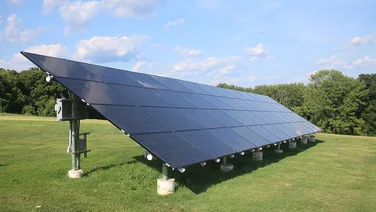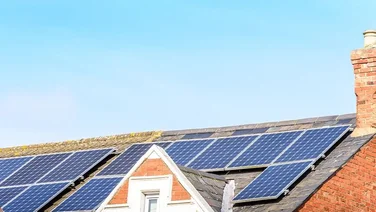- Monocrystalline solar panels are the most cost-effective option
- Perovskite panels are more efficient and will be on the market soon
- Thin film panels are the cheapest, most versatile choice
- Solar thermal panels are the most efficient at heating up water

It’s confusing enough trying to find solar panel prices, never mind choosing between the different types of solar panels to pick the right one for your home.
In this guide, we’ll run through the nine types of solar panels: monocrystalline, polycrystalline, thin film, transparent, Concentrator Photovoltaics (CPV), Passivated Emitter and Rear Contact (PERC), perovskite, solar tile, and solar thermal.
We’ll explain their main differences, costs, efficiency ratings, durability, and availability so you can decide which type is right for your needs.
Already know which type of panels your home needs? Then it’s time you start comparing prices.
To speed up this process, pop your details in this short form – we’ll put you in touch with our reliable local installers, who will provide you with prices to compare.
Where do you want to install solar panels?
Get startedWhat are the different types of solar panel?
The most common types of solar panels for UK homes are monocrystalline and polycrystalline, both made from silicon. However, there are nine main types of solar panels in total: monocrystalline, polycrystalline, thin film, transparent, Concentrator Photovoltaics (CPV), Passivated Emitter and Rear Contact (PERC), perovskite, solar tile, and solar thermal.
Each of these panels comes with its own advantages and disadvantages, and will suit some homes better than others.
To give you a clear overview, here’s how each panel performs in terms of its cost, efficiency, durability – and whether it’s currently available to buy.
| Type of solar panel | Cost per m² | Efficiency (%) | Lifespan (years) | Commercially available? |
|---|---|---|---|---|
Monocrystalline | £350 | 18-24 | 25-40 | Yes |
Polycrystalline | £280 | 13-16 | 25-30 | Yes |
Thin film | £99 | 7-13 | 10-20 | Yes |
Transparent | £250 | 1-10 | 25-30 | Yes |
CPV | N/A | 35-50 | 25-35 | No |
PERC | £360 | 17-20 | 25-35 | Yes |
Perovskite | N/A | 28.6-33.7 | 25-30 | No |
Solar tile | £294 | 10-20 | 25-30 | Yes |
Solar thermal | £670 | 70* | 20-25 | Yes |
* Solar thermal panels convert sunlight into heat, not electricity
Monocrystalline solar panels

| Average cost of 350-watt panel (including installation) | Average efficiency rating | Average lifespan |
|---|---|---|
£703 | 18-24% | 25-40 years |
✔ Currently available to homeowners
Monocrystalline panels are made of single-crystal silicon, which is melted into bars, cut into wafers, and treated with anti-reflective coating that improves its efficiency and gives it a darker appearance.
Although these aesthetically pleasing black solar panels are more expensive than other options, they’re also the most efficient solar panel for domestic households, with many companies now offering systems with more than 22% efficiency.
Their greater efficiency lies in their single-crystal silicon structure, which is capable of capturing more sunlight into electricity than alternatives like polycrystalline panels. This makes them better value overall, as you need fewer panels to achieve the same output.
They’re absolutely worth buying if you can afford the cost, which is usually between £4,000 and £10,000, because they typically cut your electricity bills by 70%, and you’ll break even on them after 13.08 years.
Find out more about how much solar panels cost in our guide.
- Best efficiency of commercially available panels
- Break-even point of 14.1 years
- Cuts the typical electricity bill by 64%
- They look sleek, modern, and subtle
- More expensive than other options
Polycrystalline solar panels

| Average cost of 350-watt panel (including installation) | Average efficiency rating | Average lifespan |
|---|---|---|
£562 | 13-16% | 25-30 years |
✔ Currently available to homeowners
Polycrystalline solar panels are made by melting multiple silicon crystals and pouring them into a square mould, which creates this panel’s blue mosaic look.
They’re slightly more eco-friendly than their monocrystalline counterparts, because less silicon is wasted during the process, and they’re often the cheaper option.
However, polycrystalline panels cost more per watt of power output, because they’re about one-third less efficient than monocrystalline panels.
This means you’ll need to use more of your roof to achieve the same power output, and you’ll ultimately pay more for a solar array that doesn’t look as sleek and modern. This makes the option best suited for homeowners with a large roof area, while those with less space would be better off going for monocrystalline, or thin film solar panels instead.
Want a direct comparison of monocrystalline and polycrystalline solar panels? Go to our review of the two types.
- Slightly more eco-friendly
- Often the cheaper option
- Cost more per watt
- One-third less efficient than monocrystalline
- Aesthetically worse than monocrystalline panels
Thin film solar panels

| Average cost of 350-watt panel (including installation) | Efficiency rating | Average lifespan |
|---|---|---|
£416 | 7-13% | 10-20 years |
✔ Currently available to homeowners
Thin film solar panels are created by placing several thin layers of photovoltaic material – amorphous silicon, cadmium telluride, copper indium gallium selenide, or organic PV cells – on top of each other.
Find out more about how solar panels are made on our page.
Depending on the material, their efficiency rating ranges from 7% to 13%.
This means thin film panels have a much lower efficiency rating than other types of solar panels, but their main asset is their flexibility.
They’re perfect for homes with limited roof space, since they can be wrapped around objects, or mobile homes like recreation vehicles. However, their poor efficiency makes them less suitable for individuals wanting to reduce electicity costs quickly.
They’re usually cheaper than monocrystalline and polycrystalline panels, but since they’re not as widely available, their price can vary depending on your local suppliers.
- Flexibility means you don't need a flat roof
- Perfect for mobile homes & sheds
- Cheaper than other domestic panels
- Poor efficiency rating
- Low power output

Transparent solar panels

| Average cost of 350-watt panel (including installation) | Efficiency rating | Average lifespan |
|---|---|---|
£1,909 | 1-10% | 25-30 years |
✘ Not widely available to homeowners
Transparent solar panels can be placed on top of glass so you can generate solar energy while still letting sunlight through. Due to their space-saving nature, and ability to blend into pre-exsisting designs, it’s likely they will be integrated into more windows, mobile phones and greenhouses in following years. ,
They’re already available for households, but their low efficiency rate and high cost mean they’re usually not worth it.
Instead, they’re typically used on commercial buildings, where the savings can be multiplied across hundreds or thousands of windows, and their design allows natural light to pass through.
They’re currently similar to thin film panels, but new models use a transparent luminescent solar concentrator to absorb light that’s invisible to humans – namely ultraviolet and infrared.
This has allowed scientists to reach 86% transparency, though versions on the market usually lie between 30% and 40%.
- Lets more sunlight through
- Can be used on multiple surfaces
- No aesthetic drawbacks
- Bad efficiency rating
- Expensive
- Low savings
Concentrator Photovoltaics (CPV)
| Average cost of 350-watt panel (including installation) | Efficiency rating | Average lifespan |
|---|---|---|
N/A | 35-50% | 25-35 years |
✘ Not currently available to homeowners
Concentrator Photovoltaics is a process where sunlight is concentrated with curved mirrors or lenses, and directed onto small, super-efficient solar cells.
This process results in intensities of 1,000 suns or higher. For context, the ideal scenario for an average household solar panel is an intensity of one sun.
CPV systems also typically use solar trackers to ensure they get the most sunlight at all parts of the day, and cooling equipment to stop solar panels overheating.
CPV arrays can mostly be found in hot regions of countries like Spain, South Africa, and the US, and are usually owned by energy companies which sell the electricity they generate to the national grid.
- Up to 50% efficient
- Uses light with the intensity of 1,000 suns or more
- Generates solar energy with very little light
- Not available to households
- Too expensive for anyone but energy companies
Passivated Emitter and Rear Contact (PERC)
| Average cost of 350-watt panel (including installation) | Efficiency rating | Average lifespan |
|---|---|---|
£817 | 17-20% | 25-35 years |
✔ Currently available to homeowners
Passivated Emitter and Rear Contact is a technological system that can be added to any domestic solar panel in the manufacturing process to boost efficiency. boost.
It involves making the rear side of the solar panel (which faces your roof) reflective, which bounces any unabsorbed light back through the cell, so the front side has another opportunity to absorb it.
And the passivation layer is designed to take in less heat, so the panel will lose less efficiency in high temperatures.
However, PERC’s day in the sun may be over. According to the International Technology Roadmap for Photovoltaic (ITRPV), while PERC technology currently makes up around 75% of the market share, it’s share is set to decrease to 10% within the next 10 years as the best solar panels now use heterojunction (HJT) or Tunnel Oxide Passivated Contact (TOPCon) technology instead.
These techniques build on PERC with other features that further increase a panel’s efficiency – making these panels more cost-effective for households than PERC models.
- More efficient than traditional panels
- Less likely to lose efficiency from overheating
- Cheaper than top-tier panels
- Less efficient than leading panels
- Increasingly unpopular with the best manufacturers
Perovskite solar panels

| Average cost of 350-watt panel (including installation) | Efficiency rating | Average lifespan |
|---|---|---|
N/A | 28.6-33.7% | 25-30 years |
✘ Not currently available to homeowners
Perovskite solar panels are made using perovskite, a synthetic material inspired by the crystal structure of a mineral with the same name.
This material is layered on top of standard silicon to form a tandem model. Silicon can already absorb the red end of the solar spectrum, but perovskite is able to absorb the blue part.
It’s able to reach efficiencies like 33.7%, which a team of scientists in Saudi Arabia achieved in May 2023 with a single perovskite-silicon cell.
In the same month, British company Oxford PV announced that its full-sized panel has attained 28.6% efficiency.
While perovskite solar panels are not currently able to be purchased commercially, research suggests they will become widely available by 2026.
- Higher efficiency than any solar panel on the market
- Takes up the same space as monocrystalline panels
- Will cut your energy bills by much more than other types
- Not yet on the market
- Will likely be more expensive than most, initially
Solar tile

| Average cost of 350 watts (including installation) | Efficiency rating | Average lifespan |
|---|---|---|
£823 | 10-20% | 25-30 years |
✔ Currently available to homeowners
Solar tiles absorb sunlight and turn it into electricity, just like other solar technologies, but they’re made to look like regular roof tiles.
That means they blend in perfectly with your roof – though you’ll need to get your entire roof replaced during the installation.
This fact, along with the small solar tile market, means you’ll pay more than you would for other options like monocrystalline, polycrystalline, and thin film solar panels.
Solar roof tiles are also around 40% less efficient than solar panels, which means your annual savings will be lower.
You should only get solar tiles if you have the money to spend and don’t like the look of solar panels, or if you live in a conservation area or listed building.
- Blends in with your roof
- Avoids regulations on listed buildings and conservation areas
- More durable than solar panels
- Worse efficiency rating than modern solar panels
- More expensive than solar panels
- Almost definitely won't break even
Solar thermal panels

| Average cost for a 3-bedroom household (including installation) | Efficiency rating | Average lifespan |
|---|---|---|
£4,000 | 70% | 20-25 years |
✔ Currently available to homeowners
Solar thermal panels use the sun’s rays to heat up your domestic hot water, rather than to provide electricity.
Also known as solar water heaters, these panels cut a typical household’s heating bill by 50%, making them one of the cheapest ways to heat your home.
They’re composed of either flat plate panels or evacuated tube collectors that collect warmth from the sun, which heats the mixture of glycol and water within.
This mixture then flows to the heat exchanger inside your hot water tank, and transfers its warmth to your water supply.
They’re easy to install and work with boilers and immersion heaters, but aren’t able to generate electricity like other options on this list, so can’t be used as a solution on their own.
- Easy to install
- Relatively cheap
- Typically cuts your heating bill in half
- Provides hot water, not electricity
- Can't provide 100% of your hot water
Where do you want to install solar panels?
Get startedWhich type of solar panel is best for you?
When you’re trying to pick the best solar panels for you, you’ll need to consider a few factors.
If aesthetics is most important to you, you should look into sleek monocrystalline solar panels, transparent solar panels that won’t draw the eye, or roof tiles, which end up being indistinguishable from the rest of your roof.
If you’re worried about the upfront cost, you can look to thin film panels, though you can achieve the best break-even point by purchasing monocrystalline panels – the cheapest commercially available option, per watt of power.
The best type of solar panel overall is monocrystalline, as it achieves the best peak power output, efficiency ratings, and break-even point, all while looking good.
However, perovskite solar panels are coming for its crown. While they aren’t widely available yet, when they are, they’ll revolutionise the market – and your electricity bill savings.
Alternatively, if you’re just looking for a way to heat up your hot water, rather than generate electricity, solar thermal panels will be your best option.
If you’re considering solar panels for your home, read our guide on the subject – and make sure you check out our article on 5 kW solar panel systems to get an idea of what you need.
Affordability is an important factor for most Brits, especially now. According to our National Home Energy Survey, the energy crisis has made 43% of people less likely to buy low carbon tech.

What is the next generation solar panels?
The solar panel industry is always developing and changing for the better, as the older models are supplanted by new, more efficient versions. Here’s what you can expect in the next few years.
Quantum dot solar panels
This new solar innovation uses ‘quantum dots’, which are tiny spheres of semiconductor material – each only about 2–10 billionths of a metre in diameter. Quantum dot solar panels could seriously increase solar efficiency.
But how, exactly? Well, light is made of particles called photons, and solar PV technology converts photons into energy. But quantum dots have something called a “multiple exciton generation” effect, which squeezes out more energy from each photon.
The size of the quantum dots are able to be adjusted too, helping the panels capture more sunlight across a greater range of wavelengths.
Although it’s still early days, studies have found that quantum dot solar cells have the potential to increase the maximum conversion efficiency of solar panels to about 66% – to compare, domestic panels on the market are only performing at 15–25%.
Quantum dot solar panels are still in the research and development phase, so the rollout of the technology is not yet imminent.
Zombie solar panels
In a bid to improve solar panel efficiency, researchers have created zombie solar panels – a new type of solar cell that can adapt to the amount of available light. This innovation will even be able to work indoors – but don’t expect them to generate much energy.
The cells are based on a surprising discovery, which found that some solar cells actually work better when the liquid electrolyte built into them dries out – hence the name “zombie solar cells”.
The cells are a type of thin film material, usually composed of a dye that absorbs light. This encourages electrons to create a current, which is then carried to the cell’s electrodes by a liquid electrolyte solution.
What’s most impressive about zombie solar panels is that they have power conversion efficiencies of 30%–34%, despite being the size of a credit card or mobile phone.
Next steps
When it comes to domestic solar panels, homeowners can choose between polycrystalline, monocrystalline, and thin film – the right type for you will depend entirely on your priorities.
Want an easy way to find the perfect set of solar panels for your home? We can speed up this process.
All you have to do is pop a few details in this short form, and let us take the reins. We’ll put you in touch with our reliable local installers, who will provide prices for you to compare.
FAQs
What type of solar panels are best for UK?
Monocrystalline solar panels are currently the best option for households in the UK.
They’re more efficient than polycrystalline, thin film, and all the other types you can buy at the moment, and not much more expensive, meaning they have the best break-even point.
However, perovskite-silicon tandem panels will soon replace monocrystalline panels as the best solar panel for domestic properties, as they’re even more efficient.
What is the most common type of solar panel?
Monocrystalline and polycrystalline solar panels are the two most common types of solar panels in the UK.
In the coming years, monocrystalline will take a significant lead over polycrystalline in terms of popularity, as all the best solar panels on the market now are made with monocrystalline.
Should I buy monocrystalline or polycrystalline solar panels?
You should buy monocrystalline solar panels, as they’re better than polycrystalline solar panels in every area.
Monocrystalline panels are about one-third more efficient, cost less per watt, and last longer than polycrystalline panels.
All of this means that you’ll break even quicker on a monocrystalline system than you would on polycrystalline system – and thanks to monocrystalline’s sleek, black appearance, your panels will look better doing it.









